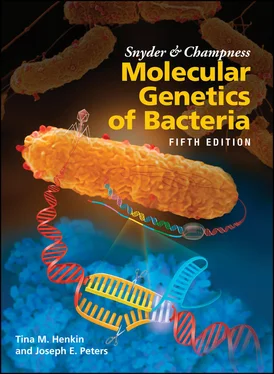RNA Processing and Modification
The folding of an RNA molecule as a result of secondary and tertiary structure represents a noncovalent change, because only hydrogen bonds or electrostatic interactions, not chemical ( covalent) bonds, are formed or broken. However, once the RNA is synihesized, RNA processingand RNA modificationcan introduce covalent changes.
RNA processing involves forming or breaking phosphate bonds in the RNA after it is made. For example, the terminal phosphates at the 5′ end may be removed, or the RNA may be cut into smaller pieces and even relegated into new combinations, requiring the breaking and making of new phosphate bonds. In one of the most extreme cases of RNA processing, called RNA editing, nucleotides can be excised from or added to mRNA after it has been transcribed from DNA.
RNA modification, in contrast, involves altering the bases or sugars of RNA. Examples include methylation of the bases or sugars of rRNA(ribosomal RNA) and enzymatic alteration of the bases of tRNA(transfer ribonucleic acid). In eukaryotes, “caps” of methylated nucleotides are added to the 5′ ends of some types of mRNA. In bacteria, mRNAs are not capped, and only the stable rRNAs and tRNAs are extensively modified.
Transcription is the synthesis of RNA by copying information from a DNA template. The overall processes of transcription are fairly similar in all organisms, but it is best understood in bacteria.
Structure of Bacterial RNA Polymerase
The transcription of DNA into RNA is carried out by RNA polymerase. In bacteria, the same RNA polymerase makes all the cellular RNAs, including rRNA, tRNA, and mRNA (but excluding the RNA primers used in DNA replication). There are approximately 2,000 molecules of RNA polymerase in each bacterial cell under slow growth conditions, with higher numbers during rapid growth. Only the primer RNAs of Okazaki fragments are made by a different RNA polymerase (primase) during DNA replication. In contrast, eukaryotes have three nuclear RNA polymerases, as well as a mitochondrial RNA polymerase, that make their cellular RNAs.
Figure 2.3shows a schematic structure of Escherichia coli RNA polymerase, which has six subunits and a molecular mass of more than 400,000 Daltons (Da) (400 kDa), making it one of the largest enzymes in the E. coli cell. The core enzyme consists of five subunits: two identical α subunits, two very large subunits called β and β′, and the ω subunit. The α, β, and β′ subunits are essential parts of the RNA polymerase, and the ω subunit helps in its assembly. A sixth subunit, the σ factor, is required only for initiation and cycles off the enzyme after initiation of transcription. Without the σ factor, the RNA polymerase is called the core enzyme; with σ, it is called the holoenzyme.
Crystal structures of RNA polymerase from Thermus aquaticus and E. coli have revealed the structure shown in Figure 2.4. The overall shape resembles a crab claw. Regions of the β and β′ subunits form the pincers of the crab claw (as shown in Figure 2.3). The two α subunits, αI and αII, are on the opposite end from the claw, making up the rear end when the enzyme is transcribing DNA. The carboxy-terminal regions of the α polypeptides hang out from the enzyme, where they can contact other proteins or DNA regions upstream of the promoter and stimulate transcription initiation (see below). The ω subunit is also on this end of the RNA polymerase, wrapped around the β′ subunit ( Figure 2.3).
The σ factor is crucial for directing RNA polymerase to recognize the promotersequence, which is the site on the DNA at which transcription initiates. When the σ factor is bound to the complex to form the holoenzyme, it wraps around the front end of the core enzyme in such a way that it can contact the DNA as it enters the open claw. One of the σ domains, domain σ 2, contacts the β′ pincer and is in position to bind to one part of the promoter sequence on the DNA (the –10 region), while two other domains, σ 3and σ 4, contact the β subunit further upstream in the active-center channel in such a way that the σ 4domain is in position to contact the –35 region of the promoter (see below). The RNA polymerases of all bacteria are probably very similar in sequence and composition. One interesting difference is that in some types of bacteria, the β and β′ subunits are attached to each other to form an even larger polypeptide. The eukaryotic and archaeal core RNA polymerases have more subunits and have very different sequences, but their basic overall structures are very similar to that of bacterial RNA polymerase.

Figure 2.3 The structure of bacterial RNA polymerase. The core enzyme is composed of the β, β′, ω, and two copies of the α protein. Addition of the σ protein results in formation of the holoenzyme, which is the form required for initiation of transcription. The functions of some of the domains of σ, σ 1, and σ 3.2are discussed in this chapter.

Figure 2.4 Crystal structure of bacterial RNA polymerase and σ interactions with promoter DNA. Subunits of RNA polymerase are shown. The α subunits are divided into the α subunit amino-terminal domains (αNTD), which associate with the β and β′ subunits, and the α subunit carboxy-terminal domains (αCTD), which can bind to the UP element in the DNA. The structures of the αCTDs are not resolved and are shown as balls. σ is divided into four domains that extend along the promoter DNA, interacting with different regions of the promoter. From Murakami KS, Masuda S, Campbell EA, et al, Science 296:128 5 –1290, 2002. Modified with permission from AAAS.
Overview of Transcription
Much like DNA polymerase (see chapter 1), RNA polymerase makes a complementary copy of a DNA template, building a chain of RNA by attaching the 5′ phosphate of a ribonucleotide to the 3′ hydroxyl of the one preceding it in the growing chain ( Figure 2.5A). However, in contrast to DNA polymerases, RNA polymerases do not need a preexisting primer to initiate the synthesis of a new chain of RNA. To begin transcription, the RNA polymerase holoenzyme binds to the promoter sequence and separates the strands of the DNA, exposing the bases. Unlike DNA polymerases, which require helicases to separate the strands, the RNA polymerase can complete this step by itself. Then, an rNTP complementary to the nucleotide at the transcription start siteenters the complex through a channel in the RNA polymerase and pairs with the template; this first rNTP is usually ATP or GTP. The second rNTP comes in, and if it is complementary to the next base in the DNA template, it is retained, but if it is not complementary, it is rejected. RNA polymerase then catalyzes the reaction in which the α phosphate of the second nucleotide joins with the 3′ hydroxyl of the first nucleotide. Then, the third nucleotide comes in and pairs with the next nucleotide in the template, and so forth. In this way, RNA polymerase makes a complementary copy, i.e., transcribesthe sequence of one strand of DNA into RNA. As shown in Figure 2.5B, the strands of DNA in a region that is transcribed are named to reflect the sequence of the RNA made from that region. The template strandof DNA that is copied is also called the transcribed strand. The other strand of the DNA, which has the same sequence as the RNA copy, is called the nontemplate strandor coding strand, since it has the same sequence as the mRNA that encodes the protein (even if the RNA that is made does not actually encode a protein). The sequence of a gene is usually written as the sequence of the nontemplate, or coding, strand.
Читать дальше













